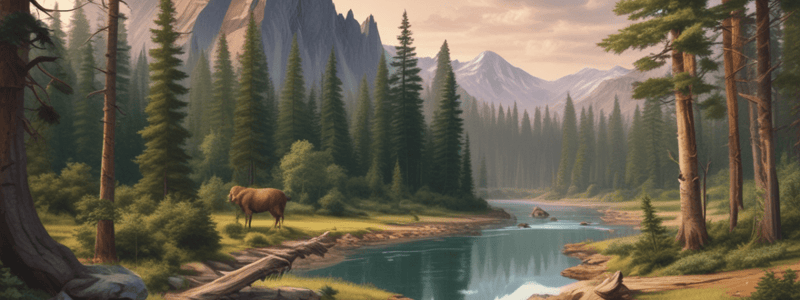Podcast
Questions and Answers
What is a characteristic of a wilderness area?
What is a characteristic of a wilderness area?
- High population density of humans
- Presence of roads and buildings
- Absence of human development and disturbance (correct)
- Complete eradication of all wildlife
Who wrote the Wilderness Act?
Who wrote the Wilderness Act?
- Franklin D. Roosevelt
- Howard Zahniser (correct)
- President Lyndon B. Johnson
- Theodore Roosevelt
What is a benefit of wilderness areas?
What is a benefit of wilderness areas?
- Hosting large-scale industrial activities
- Supporting large-scale agriculture
- Naturally filtering water (correct)
- Providing habitat for invasive species
What is the purpose of the Wilderness Act?
What is the purpose of the Wilderness Act?
Where can wilderness areas be found?
Where can wilderness areas be found?
What is the primary mechanism by which water is cleaned of contaminants when it enters wilderness areas?
What is the primary mechanism by which water is cleaned of contaminants when it enters wilderness areas?
Which of the following activities is NOT allowed in wilderness areas?
Which of the following activities is NOT allowed in wilderness areas?
What is a major concern for wilderness areas due to the expansion of cities and towns?
What is a major concern for wilderness areas due to the expansion of cities and towns?
Which of the following wilderness areas is known for its opportunities for canoeing?
Which of the following wilderness areas is known for its opportunities for canoeing?
What is the primary purpose of the 'Leave no Trace' policy in wilderness areas?
What is the primary purpose of the 'Leave no Trace' policy in wilderness areas?
Flashcards are hidden until you start studying
Study Notes
Definition of Wilderness
- Wilderness is a region or tract of land that has not been disturbed or developed by humans.
- There is no sign of humans in the wilderness, including roads, buildings, pipelines, or powerlines.
Wilderness Areas
- Wilderness areas are untamed and some of the last completely natural and untouched areas left in the world.
- They provide resources for a variety of plants and animals.
- Wilderness areas are protected from any development, such as roads, buildings, or farms.
The Wilderness Act
- The Wilderness Act was signed by President Lyndon B. Johnson in 1964.
- The bill was written by Howard Zahniser, the executive director of the Wilderness Society.
- The Wilderness Act allows for parts of the United States to be designated wilderness areas.
- The National Wilderness Preservation System was created from the Wilderness Act, giving long-term protection to wilderness areas in their natural state.
- There are 757 areas and over 109 million acres of land in 44 states and Puerto Rico that are protected by the Wilderness Act and designated as wilderness.
Benefits of Wilderness Areas
- Wilderness areas provide clean water through natural filtration.
- They provide excellent wildlife habitats, promoting biodiversity and allowing endangered species to thrive.
- Wilderness areas serve as natural laboratories for science and education.
- They provide opportunities for recreation, such as hiking, fishing, and horseback riding, without the use of mechanized transportation.
Concerns for Wilderness
- Water and air pollution from surrounding cities, industrial, and agricultural activities affect the native species.
- Excess greenhouse gases in the atmosphere from sources such as farms, automobile exhaust, and industrial emissions are a concern.
Wilderness Areas in the U.S.
- Millions of people visit wilderness areas every year.
- Examples of wilderness areas in the USA include:
- Boundary Waters Canoe Area Wilderness, Minnesota
- Sandia Mountain Wilderness, New Mexico
- Alpine Lakes Wilderness, Washington
Studying That Suits You
Use AI to generate personalized quizzes and flashcards to suit your learning preferences.



